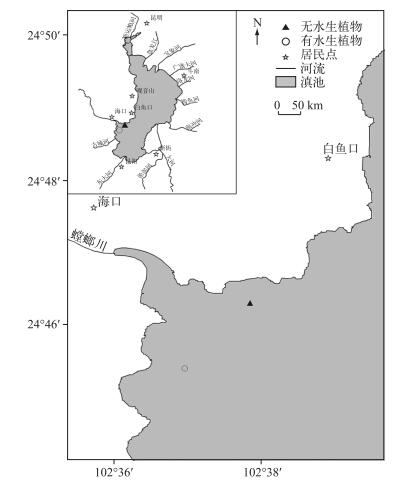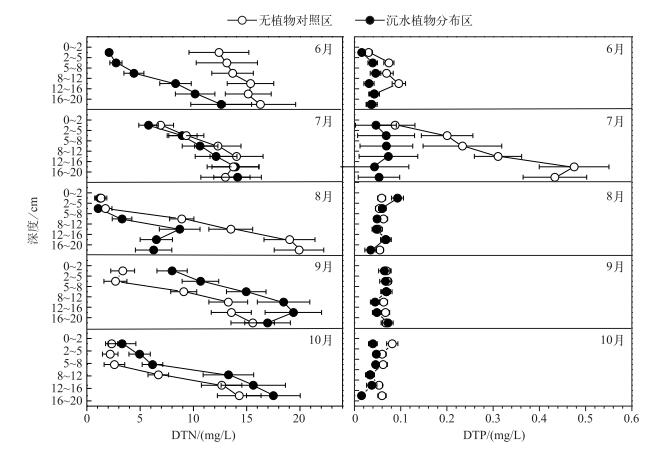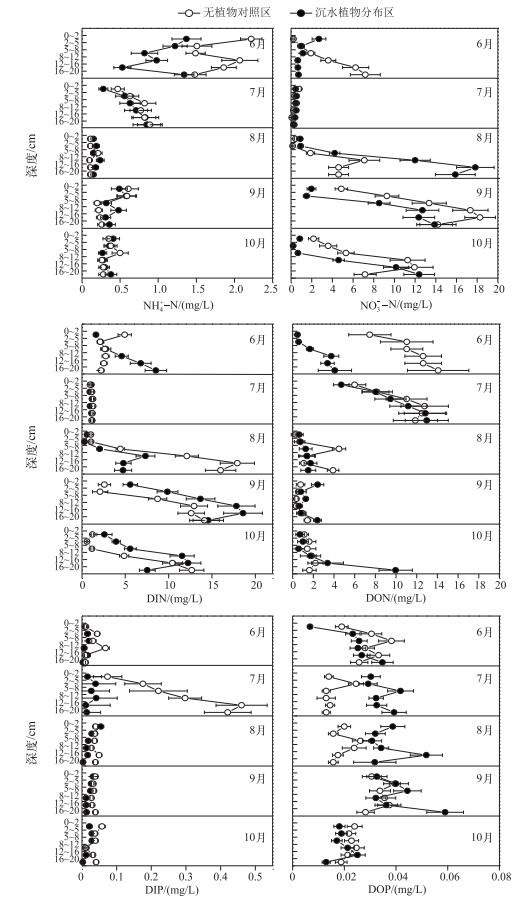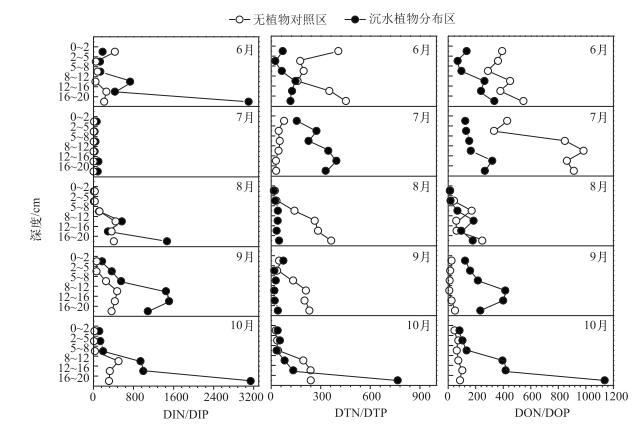(2: 中国环境科学研究院, 环境基准与风险评估国家重点实验室, 北京 100012)
(3: 中国环境科学研究院国家环境保护湖泊污染控制重点实验室, 湖泊生态环境创新基地, 北京 100012)
(4: 云南省高原湖泊流域污染过程与管理重点实验室, 昆明 650034)
(2: State Key Laboratory of Environmental Criteria and Risk Assessment, Chinese Research Academy of Environmental Sciences, Beijing 100012, P. R. China)
(3: Research Center of Lake Eco-Environment, State Environmental Protection Key Laboratory for Lake Pollution Control, Chinese Research Academy of Environmental Sciences, Beijing 100012, P. R. China)
(4: Yunnan Key Laboratory of Pollution Process and Management of Plateau Lake-Watershed, Kunming 650034, P. R. China)
富营养化是由于湖泊水体大量营养盐输入,导致藻类大量繁殖、水体透明度及溶解氧浓度降低,而氮、磷是引起湖泊富营养化的重要环境因子[1-4].水生植物是浅水湖泊生态系统中最重要的生产者,对沉积物中氮、磷形态、含量及分布动态有重要影响.水生植物通过根系吸收和引起根际环境的改变使沉积物间隙水中氮、磷浓度降低,这在一定程度上可以降低沉积物氮、磷向上覆水释放的风险且水生植物对不同形态的磷影响不同[5-6].但许多发生富营养化的浅水湖泊生态系统中水生植物减少或消失[7-9],导致大面积的蓝藻水华暴发.蓝藻暴发对沉积物氮形态(NH4+-N、NO3--N和Org-N)含量及比例影响不显著,但造成沉积物活性磷(LP和Fe/Al-P)和生物有效性磷(AAP)占总磷比例减少,惰性磷(Ca-P)和有机磷(Org-P)比例增加[10].周小宁等[11]发现沉水植物黑藻对沉积物磷有活化作用,会增加沉积物中潜在可交换磷的量,植物根系分泌物释放到沉积物中,引起沉积物pH、氧化还原电位及微生物活性等理化性质的改变.不仅分泌物能影响沉积物理化性质,而且植物根系活力能够促进微生物的生长,改变微生物群落结构组成,进而影响沉积物中氮、磷营养盐形态转换[12-14].间隙水是上覆水与沉积物氮、磷迁移转化的中转站,其氮、磷形态贡献百分比变化反映了不同形态氮、磷季节性差异[15].间隙水氮、磷形态包括溶解性氨氮、硝态氮、亚硝态氮、溶解性磷酸盐、以及由蛋白质、肽、氨基酸、核酸及相关色素、腐殖质等物质构成的溶解性有机氮和由磷酸酯、磷脂和核酸等物质构成的溶解性有机磷等几个部分[16].间隙水氮、磷主要来源于沉积物有机氮、磷矿化降解和无机氮、磷的溶解过程[17],而浮游动物、水生植物及藻类等残体在微生物作用下分解也是间隙水氮、磷的重要来源[18].
近年来,一些学者关注水生植物对间隙水氮、磷浓度及沉积物-水界面释放过程的影响.孔祥虹等[19]研究了长江中下游湖泊主要水生植物分布状况及水环境因子对水生植物分布的影响.结果表明总氮浓度、pH值和水深是显著影响不同营养水平湖泊水生植物分布的主导因子.沉水植物根系分泌物能改变根际微环境中的溶解氧浓度和氧化还原电位,从而改变沉积物的矿化速率,进而影响氮形态贡献[20].与无植物分布区相比,水生植物能显著提高沉积物中微生物活性,植物根系分泌碳水化合物、有机酸和氨基酸类等物质,促进能利用碳源的微生物大量繁殖,影响了根际微生物群落结构[21].氮、磷的大量输入在一定程度上改变了水体营养和生物群落结构,且氮、磷之间的耦合作用亦制约着水生生态系统中生物群落结构.水生植物生长过程中对氮、磷形态吸收具有选择性及不同水生植物生长对所需氮、磷营养比例关系各不相同,导致间隙水中溶解性无机氮/溶解性无机磷、溶解性有机氮/溶解性有机磷比值存在季节差异[22-23],氮、磷比直接影响浮游生物生长、细胞组成和群落演替[24],当溶解有机氮、铵态氮分别作为生态群落中的氮源时,浮游植物群落的组成将有所不同[25].所以,氮、磷营养供应及其比例对水生生物群落结构有重要的决定作用.尽管如此,上述研究多数集中在实验室模拟条件,而对现场监测水生植物对间隙水氮、磷浓度及其形态组成的影响较少,丁帅等[26]研究表明水生植物生长能显著影响沉积物间隙水中不同形态氮浓度分布,显著提高间隙水中无机氮所占的比例.本研究通过现场监测滇池沉水植物生长过程与无植物对照区间隙水氮、磷浓度,从沉水植物对间隙水氮、磷浓度、形态贡献和氮磷比及其季节性变化影响方面,阐明沉水植物生长在湖泊沉积物-水界面过程中的作用,为沉水植物修复作为沉积物内负荷控制的技术途径及滇池富营养化治理提供理论支撑.
1 研究区域与材料方法 1.1 研究区域概况分别在2015年6、7、8、9、10月定点采集滇池有水生植物分布区(24°45′25″N,102°36′58″E)和无水生植物对照区(24°46′19″N,102°37′51″E)柱状沉积物(图 1).滇池有水生植物生长的湖区,位于滇池出水口海口,现场测定水生植物生长区水深约2.5 m,pH为7.85,透明度为45 cm,主要分布有沉水植物黄丝草和篦齿眼子菜,篦齿眼子菜为优势种群,水面上零星漂浮有水葫芦,沉水植物盖度在10 % ~20 %之间,平均生物量1237 g/m2,6-8月为滇池沉水植物生长较为旺盛的季节,9-10月为滇池沉水植物由旺盛生长转为衰亡的季节.同时在有水生植物分布附近区域相隔20~50 m且无水生植物生长区采集柱状沉积物样,无植物对照区水深约3 m,pH为7.45,透明度为30 cm,通过GPS定位确保每个月采集的柱状沉积物在同一位置.柱状沉积物样品采用管径为90 mm的硬质有机玻璃管重力采样器采集,柱状样两端用塞子封闭后,使用胶带缠住塞子与硬质玻璃管使其固定,保持避光垂直放置并及时带回实验室进行分层,运输过程要求平稳,避免沉积物-水界面受到剧烈扰动.研究区域柱状沉积物基本理化特征见表 1.

|
图 1 滇池采样点 Fig.1 Sampling sites in Lake Dianchi |
| 表 1 研究区域柱状沉积物的基本理化特征* Tab.1 Basic physical and chemical characteristics of the columnar sediment research area |
采集好的柱状样带回实验室,其上覆水的采集和沉积物分割方法参考文献[26],用虹吸管吸取柱状样上覆水,测定相关氮、磷指标.从表层向下按0~2、2~5、5~8、8~12、12~16、16~20 cm 6个间隔对柱状沉积物样品进行分层,分层出来的沉积物立即使用离心机在5000转/min离心10 min获取间隙水.间隙水中溶解性总氮(DTN)、铵态氮(NH4+-N)、硝态氮(NO3--N)、溶解性总磷(DTP)和溶解性活性磷(SRP)浓度按照《水和废水监测分析方法》进行测定[27];DTN浓度经碱性过硫酸钾消解后用紫外分光光度法测定,DTP浓度经过硫酸钾消解后用钼锑抗比色法测定,NH4+-N浓度用纳氏试剂分光光度法测定,NO3--N浓度采用紫外分光光度法测定,由于NO2--N浓度较低,故该研究中将之忽略不计.溶解性有机氮(DON)=DTN-溶解性无机氮(DIN),DIN=NH4+-N+NO3--N,溶解性有机磷(DOP)=DTP-SRP.沉积物中TN、EN、OM、MON、TP等按照文献[28-29]的方法测定,粒径采用激光粒度仪测定[30].
1.3 数据处理数据处理及分析采用Excel 2013和SPSS 20.0软件完成,采用配对样本T检验进行方差分析和差异显著性检验.采用Origin 8.5软件作图.
2 结果与分析 2.1 滇池沉水植物分布对间隙水DTN和DTP浓度时空变化的影响滇池沉水植物分布区与无植物对照区间隙水DTN和DTP浓度时空变化差异性显著(图 2),6-10月间隙水DTN浓度均随着柱状沉积物深度的增加呈显著增加趋势,与此同时,6-8月无植物对照区间隙水DTN浓度高于沉水植物分布区DTN浓度,并且6、8月二者之间达到了显著差异(P < 0.01,n=6),而9-10月与之相反. 6、7月间隙水DTP浓度随着柱状沉积物深度的增加呈显著增加趋势,但8-10月其变化趋势不明显.此外,6-10月间隙水DTP浓度均以无植物对照区高于沉水植物分布区,并且在7月和10月二者之间呈显著差异(P < 0.05,n=6).

|
图 2 滇池沉水植物分布区与无植物对照区间隙水DTN和DTP的时空变化 Fig.2 Spatial-temporal variations of DTN and DTP in interstitial water in submerged plant areas and non-submerged plant areas in Lake Dianchi |
滇池沉水植物分布区与无植物对照区间隙水不同形态氮、磷浓度及其贡献百分比时空变化显著,6、9和10月沉水植物分布区DIN浓度高于无植物对照区,而7-8月则与之相反,除6、9月沉水植物分布区DON、DIN浓度与无植物对照区有显著差异(P < 0.001,n=6)之外,其它月份二者之间的差异均未达到显著水平(图 3和表 2). 7、9和10月无植物对照区间隙水DIP浓度显著高于沉水植物分布区(P < 0.05,n=6),而7和8月沉水植物分布区间隙水DOP浓度显著高于无植物对照区(P < 0.01,n=6),其它月份二者之间差异不显著.由图 3和图 4可见,沉水植物分布区间隙水DIN和DON浓度分别变化在0.94~18.59 mg/L和0.47~12.98 mg/L之间,平均占DTN浓度的61.06 %和38.94 %,无植物对照区DIN和DON浓度分别变化在0.58~17.94和0.30~12.77 mg/L之间,平均占DTN浓度的51.25 %和48.75 %.沉水植物分布区间隙水DIP和DOP浓度分别变化在0.002~0.054和0.007~0.059 mg/L之间,平均占DTP浓度的36.89 %和63.10 %,无植物对照区DIP和DOP浓度分别变化在0.01~0.46和0.01~0.04 mg/L之间,平均占DTP浓度的62.15 %和37.84 %.

|
图 3 滇池沉水植物分布区与无植物对照区间隙水中不同氮、磷形态的时空变化 Fig.3 Spatial-temporal variations of different nitrogen and phosphorus forms in interstitial water in submerged plant areas and non-submerged plant areas in Lake Dianchi |
| 表 2 滇池沉水植物分布区与无植物对照区间隙水中不同形态氮、磷浓度差异性比较(配对样品T检验, n=6) Tab.2 Interstitial water concentrations of different nitrogen and phosphorus forms compared by difference in submerged plant areas and without submerged plant areas in Lake Dianchi (Paired-Samples T test, n=6) |

|
图 4 滇池沉水植物分布区与无植物对照区间隙水中不同氮、磷形态贡献的时空变化 Fig.4 Spatial-temporal variations of contribution of different nitrogen and phosphorus forms ininterstitial water in submerged plant areas and non-submerged plant areas in Lake Dianchi |
滇池沉水植物对间隙水不同形态氮磷比影响显著.沉水植物分布区间隙水DTN/DTP比变化在17~1136之间,平均为223;DIN/DIP比变化在11~3140之间,平均为606;DON/DOP比变化在16~767之间,平均为127 (图 5).无植物对照区间隙水DTN/DTP比变化在22~452之间,平均为159;DIN/DIP比变化在3~ 501之间,平均为178;DON/DOP比变化在9~983之间,平均为266;6-10月,沉水植物分布区DIN/DIP比总体高于无植物对照区,且随深度增加DIN/DIP比呈增加趋势,6、9和10月表现更为突出.相反,DON/DOP比则无植物对照区高于沉水植物分布区,以6、7月表现更为突出,无植物对照区与沉水植物分布区DTN/DTP比随季节交替变化,7、9和10月沉水植物DTN/DTP比高于无植物对照区,6和8月则与之相反.

|
图 5 滇池沉水植物分布区与无植物对照区间隙水中氮/磷比值的时空变化 Fig.5 Comparison of change in time and space about ratio of nitrogen and phosphorus in sediment interstitial water in submerged plant areas and non-submerged plant areas in Lake Dianchi |
本研究发现,滇池沉水植物生长及衰亡过程对沉积物间隙水氮、磷浓度及其形态组成贡献影响显著. 6-8月为滇池沉水植物生长较为旺盛的季节,该阶段大部分沉水植物生物量处于指数增长期,为了满足自身生长需要,沉水植物通过根系大量吸收间隙水中的氮、磷,从而削减了间隙水氮、磷浓度.王立志等[31]研究表明,间隙水各形态磷含量与沉水植物生物量呈现指数降低关系.王圣瑞等[32]研究发现,种植沉水植物黑藻组其沉积物间隙水氮、磷浓度明显低于对照处理组,主要与沉水植物根系对间隙水氮、磷吸收有关.根系向沉积物中泌氧,改变氧化还原条件,有利于增加铁氧化菌和铁还原菌的数量,促进沉积物中微生物铁循环,进而促进氮和磷形态转化[33].值得提出的是,沉水植物对间隙水氮、磷浓度的影响在时间上存在明显的差异.本研究发现,与无植物对照区相比,沉水植物分布区对间隙水氮浓度的削减主要发生在6、8月,而对间隙水磷浓度的削减主要发生在7月,这种时间上的差异可能与沉水植物对氮、磷2种元素吸收利用机制不同及微生物群落结构的季节变化有关.包先明等[34]通过沉水植物培养实验得出,随着沉水植物生长及生物量的增加,沉积物垂向各层间隙水氨氮浓度逐步降低,而间隙水磷酸盐浓度则随植物生长呈单峰曲线变化,认为沉水植物生长过程中对氮、磷吸收的生物地球化学循环机制不同.除此之外,水生植物根际功能微生物多样性及丰富程度远高于无植物分布区域,且硝化细菌和反硝化细菌各个季节分布不一, 是氮、磷出现季节性差异的原因之一[35-36]. 9-10月为滇池沉水植物由旺盛生长开始转为衰亡的季节,该阶段大部分沉水植物生物量处于稳定期和衰亡期,由于沉水植物衰亡而引起的自身氮代谢过程很可能是滇池沉水植物分布区间隙水氮浓度显著高于无植物对照区的主要原因[37].申秋实等[38]研究表明,太湖草源性“湖泛”暴发期间隙水氨氮、磷酸盐及Fe2+浓度远高于未发生区,主要与水生植物残体所营造的厌氧环境有关,而“湖泛”水域菹草等水植物死亡降解是间隙水氮、磷等营养盐浓度升高的重要原因之一.尽管如此,该阶段间隙水磷浓度仍为无植物对照区高于沉水植物分布区,表明沉水植物衰亡引起的自身磷代谢过程相对较为缓慢,其对间隙水磷贡献较小.
间隙水氮、磷形态贡献百分比变化反映了不同形态氮、磷在时间和空间上的转化过程[39].间隙水中氮、磷组分是生物生命活动中重要的营养和能量来源. DON和DOP是间隙水中重要的有机氮素、磷素形态且具有较高的生物有效性[40].研究表明,水生植物改变了间隙水不同形态氮、磷的分布规律,水生植物通过改变沉积物物理化学性质及界面环境条件,抑制了沉积物无机氮、磷的释放,促进了溶解性有机氮、磷的转化[41]. Wang等[42]研究认为,水生植物生长增加了表层沉积物有机质、铁、铝、钙等含量,改变了沉积物-水界面氮、磷过程,使沉积物具有较强氮、磷吸附能力,降低了沉积物氮、磷和活性组分含量,进而降低了沉积物磷释放.本研究发现间隙水氮形态组成贡献受季节性变化影响较大,6、7月间隙水氮形态以DON贡献为主,其中沉水植物分布区DON贡献达到61 %,而无植物对照区DON贡献达到了84 %;而8-10月间隙水氮形态以DIN贡献为主,沉水植物分布区和无植物对照区DIN平均贡献分别达到了76 %和75 %,表明滇池沉水植物生长过程促进了DON向DIN的转化过程.沉水植物分布区磷形态组成贡献受季节性影响较小,但随深度变化差异明显,随着沉积物深度的增加,间隙水DIP贡献百分比呈下降趋势,DOP贡献百分比呈增加趋势,表明DOP的转化过程与沉水植物的根系分布密切相关[43].无植物对照区间隙水磷形态组成主要与季节性变化有关,6-10月,间隙水DIP贡献百分比呈现先增加后下降的趋势,而DOP贡献百分比则呈现先降低后增加的趋势.相比较而言,6-10月无植物对照区DON对DTN的贡献比沉水植物分布区增加了近10 %,相反,无植物对照区DOP对DTP的贡献比沉水植物分布区降低近25 %.可见,沉水植物分布对DON和DOP利用和转化的生物地球化学过程不同[44],其机理需要进一步研究探讨.
上覆水氮磷比在湖泊富营养化及藻类水华中扮演着重要作用,而很少有研究关注沉积物间隙水氮磷比的问题[45-46]. Schindler[47]通过操纵安大略实验湖的营养盐浓度,通过施加缺氮肥料或只施加磷肥来降低氮磷比,结果发现低氮磷比能诱导鱼腥藻和束丝藻的大量发生,因此认为低N/P比更易导致蓝藻水华暴发.浮游植物健康生长及生理平衡所需氮磷原子比为16 :1,若N/P比值小于16,表明氮为浮游植物生长的限制因子;若N/P大于16,则磷为浮游植物生长的限制因子.最新研究表明,N/P比在浮游植物细胞中的16 :1的比率可以用蛋白质和核糖核酸两者的合成来解释[48].尽管浮游植物化学变化受区域环境条件限制和浮游植物生长策略的影响[49-50],但浮游植物C :N :P平均比值在较大的时空变化尺度上是相对恒定的[51]. Smith等[52]基于17个湖泊的调查发现,湖泊水质N/P比与蓝藻水华暴发关系密切,当N/P比值低于29时,湖泊发生水华的风险更高[53].蓝藻水华暴发导致氮浓度下降,磷浓度升高,N/P比值减小.由此可见,N/P比与浮游植物生长及蓝藻暴发密切相关.本研究发现,间隙水DTN/DTP(沉水植物分布区223和无植物对照区159)、DIN/DIP(沉水植物分布区606和无植物对照区178)和DON/DOP(沉水植物分布区127和无植物对照区266)平均值均显著高于16,在某一时段较深区域的间隙水DTN/DTP和DON/DOP可达到200以上,DIN/DIP达到1000以上,而且间隙水氮磷比显著高于滇池上覆水DTN/DTP(47)、DIN/DIP(68)和DON/DOP(29)的平均水平.总体上来讲,沉水植物生长显著增加沉积物间隙水的DTN/DTP,尤其是DIN/DIP,相反,降低了DON/DOP.因此,沉水植物对间隙水氮磷吸收及转化过程改变了沉积物氮磷释放机制,从而影响上覆水氮磷形态组成及氮磷比,很可能影响到浮游植物生长及藻类水华过程.
4 结论1) 滇池沉水植物生长及衰亡过程显著影响间隙水氮、磷浓度,反映了沉水植物对氮、磷2种元素的生物地球化学循环作用机制不同.
2) 间隙水氮形态贡献受季节性变化影响较大.沉水植物分布区磷形态贡献受季节变化影响较小,但随深度变化差异明显,间隙水磷形态的转化过程主要与沉水植物分布有关.
3) 沉水植物生长对沉积物间隙水各形态氮磷比影响显著.沉水植物生长显著增加间隙水的DTN/DTP,尤其是DIN/DIP,相反降低DON/DOP.
| [1] |
Guo HC, Wang XY, Yi X. Based on aquatic ecosystem succession eutrophication control strategiesin Lake Dianchi. Geographical Research, 2013, 32(6): 999-1006. [郭怀成, 王心宇, 伊璇. 基于滇池水生态系统演替的富营养化控制策略. 地理研究, 2013, 32(6): 999-1006.] |
| [2] |
Dai Y, Wu S, Chang J et al. Effects of Ceratophyllum demersum, L. restoration on phosphorus balance at water-sediment interface. Ecological Engineering, 2012, 44(3): 128-132. |
| [3] |
Backer SD, Teissier S, Triest L. Stabilizing the clear-water state in eutrophic ponds after biomanipulation:Submerged vegetation versus fish recolonization. Hydrobiologia, 2012, 689(1): 161-176. DOI:10.1007/s10750-011-0902-2 |
| [4] |
Le C, Zha Y, Li Y et al. Eutrophication of lake waters in China:Cost, causes, and control. Environmental Management, 2010, 45(4): 662-668. DOI:10.1007/s00267-010-9440-3 |
| [5] |
Bai X, Chen KN, Ren KX et al. Myriophyllum growth effect on nitrogen and phosphorus in sediments in the condition of different water depths. Ecology and Environmental Sciences, 2011, 20(6/7): 1086-1091. [柏祥, 陈开宁, 任奎晓等. 不同水深条件下狐尾藻生长对沉积物氮磷的影响. 生态环境学报, 2011, 20(6/7): 1086-1091.] |
| [6] |
Hu J, Feng MY, Wu YH et al. Effects on phosphorus fraction distribution in sediment by submerged plant. Environmental Chemistry, 2006, 25(1): 28-31. [胡俊, 丰民义, 吴永红等. 沉水植物对沉积物中磷赋存形态影响的初步研究. 环境化学, 2006, 25(1): 28-31.] |
| [7] |
Shields EC, Moore KA. Effects of sediment and salinity on the growth and competitive abilities of three submersed macrophytes. Aquatic Botany, 2016, 132: 24-29. DOI:10.1016/j.aquabot.2016.03.005 |
| [8] |
Scheffer M, Szabó S, Gragnani A et al. Floating plant dominance as a stable state. Proceedings of the National Academy of Sciences of the United States of America, 2003, 100(7): 4040-4045. DOI:10.1073/pnas.0737918100 |
| [9] |
Correll N, David L. Role of phosphorus in the eutrophication of receiving waters:A review. Journal of Environmental Quality, 1998, 27(2): 261-266. |
| [10] |
Kong M, Zhang L, Yin HB et al. Influence of algae bloom on distribution of total and speciation of nitrogen and phosphorusin the surfacesediments from Lake Chaohu. China Environmental Sciences, 2014, 5(5): 1285-1292. [孔明, 张路, 尹洪斌等. 蓝藻暴发对巢湖表层沉积物氮磷及形态分布的影响. 中国环境科学, 2014, 5(5): 1285-1292.] |
| [11] |
Zhou XN, Wang SR, Jin XC. Influence of submerged vegetation Hydrilla verticillata on the forms of organic and inorganic phosphorus and potential exchangeable phosphorus in sediments. Environmental Science, 2006, 27(12): 2421-2425. [周小宁, 王圣瑞, 金相灿. 沉水植物黑藻对沉积物有机, 无机磷形态及潜在可交换性磷的影响. 环境科学, 2006, 27(12): 2421-2425. DOI:10.3321/j.issn:0250-3301.2006.12.010] |
| [12] |
Thoms C, Gleixner G. Seasonal differences in tree species' influence on soil microbial communities. Soil Biology & Biochemistry, 2013, 66(66): 239-248. |
| [13] |
Gul S, Whalen JK, Ellis BE et al. Plant residue chemistry impacts soil processes and microbial community structure:A study with Arabidopsis thaliana cell wall mutants. Applied Soil Ecology, 2012, 60(4): 84-91. |
| [14] |
Peng Q, Xie B, Yuan Q et al. Preliminary study on the changes of bacterial community strcuture in Qingcaosha reservoir during water storage period. Environmental Science, 2012, 33(10): 3634-3640. [彭青, 谢冰, 袁琦等. 青草沙水库蓄水期间细菌群落结构变化的初步研究. 环境科学, 2012, 33(10): 3634-3640.] |
| [15] |
Meng CH, Zhao B. Vertical distribution of species of nitrogen and phosphorus in the sediments of Donghu Lake. Environmental Science, 2008, 29(7): 1831-1837. [孟春红, 赵冰. 东湖沉积物中氮磷形态分布的研究. 环境科学, 2008, 29(7): 1831-1837.] |
| [16] |
Fan CX, Yang LY, Zhang L. The analysis of vertical distribution and correlation that nitrogen and phosphorus in the pore water of sediment in Taihu Lake. J Lake Sci, 2000, 12(4): 359-366. [范成新, 杨龙元, 张路. 太湖底泥及其间隙水中氮磷垂直分布及相互关系分析. 湖泊科学, 2000, 12(4): 359-366. DOI:10.18307/2000.0410] |
| [17] |
Tian RN, Zhu M, Liu M et al. Nitrogen and phosphorus removel effects of different hydrophyte combitations under simulated eutrophic conditions. Journals of Beijing Forestry Universty, 2011, 3(6): 191-195. [田如男, 朱敏, 孙欣欣等. 不同水生植物组合对水体氮磷去除效果的模拟研究. 北京林业大学学报, 2011, 3(6): 191-195.] |
| [18] |
Li ZG, Wang GX, Zhang J et al. Effects on phosphorus fraction distribution in sediment by roots of Vallisneria natans. Environmental Science, 2014, 35(4): 1304-1310. [李振国, 王国祥, 张佳等. 苦草(Vallisneria natans)根系对沉积物中各形态磷的影响. 环境科学, 2014, 35(4): 1304-1310.] |
| [19] |
Kong XH, Xiao LL, Su HJ et al. Status of aquatic plant and its relationship with water enviriment factors in the lakes along the lower reaches of the Yangtze River. J Lake Sci, 2015, 27(3): 385-391. [孔祥虹, 肖兰兰, 苏豪杰等. 长江下游湖泊水生植物现状及与水环境因子的关系. 湖泊科学, 2015, 27(3): 385-391. DOI:10.18307/2015.0303] |
| [20] |
Søndergaard M, Phillips G, Hellsten S et al. Maximum growing depth of submerged macrophytes in European lakes. Hydrobiologia, 2013, 704(1): 165-177. DOI:10.1007/s10750-012-1389-1 |
| [21] |
Li ZG, Wang GX, Zhang J et al. Effects on phosphorus fraction distribution in sediment by roots of Vallisneria natans. Environmental Science, 2014, 35(4): 1304-1310. [李振国, 王国祥, 张佳等. 苦草(Vallisneria natans)根系对沉积物中各形态磷的影响. 环境科学, 2014, 35(4): 1304-1310.] |
| [22] |
Zhou T, Li ZK, Feng LL. The different roles of ammonium and nitrate in the bloom self-maintenance of Lake Taihu. China Environmental Sciences, 2013, 33(2): 305-311. [周涛, 李正魁, 冯露露. 氨氮和硝氮在太湖水华自维持中的不同作用. 中国环境科学, 2013, 33(2): 305-311.] |
| [23] |
Lin Y, Zhuang D, Chen X et al. A preliminary analysis on the enclosed experimental results of red tide formationⅡ. Phytoplankton succession and dino-flagellate red tide. Chin J Appl Ecol, 1994, 5(3): 314-318. |
| [24] |
Shi YJ, Hu HH, Ma RY et al. Nitrogen and phosphorus absorption and growth characteristics of Alexandrium tamarense. Journal of Applied Ecology, 2003, 14(7): 1143-1146. [石岩峻, 胡晗华, 马润宇等. 塔玛亚历山大藻对氮和磷的吸收及其生长特性. 应用生态学报, 2003, 14(7): 1143-1146.] |
| [25] |
Bronk DA, Glibert PM, Ward BB. Nitrogen uptake, dissolved organic nitrogen release, and new production. Science, 1994, 265(5180): 1843-1846. DOI:10.1126/science.265.5180.1843 |
| [26] |
Ding S, Jiao LX, Wang SR et al. The concentration of different nitrogen forms in interstitial water along sediments column as affected by aquatic plant in Lake Dianchi. China Environmental Sciences, 2016, 29(5): 700-707. [丁帅, 焦立新, 王圣瑞等. 滇池水生植物分布对沉积物间隙水中不同形态氮的影响. 环境科学研究, 2016, 29(5): 700-707.] |
| [27] |
The State environmental protection administration. Water and wastewater monitoring analytic method. 4th ed. Beijing: Chinese Environmental Science Press, 2002, 254-279. [国家环境保护总局. 水和废水监测分析方法: 第4版. 北京: 中国环境科学出版社, 2002, 254-279.]
|
| [28] |
Meng YY, Wang SR, Jiao LX et al. Characteristics of nitrogen pollution and the potential mineralization in surface sediments of Dianchi Lake. Environmental Science, 2015(2): 471-480. [孟亚媛, 王圣瑞, 焦立新等. 滇池表层沉积物氮污染特征及其潜在矿化能力. 环境科学, 2015(2): 471-480.] |
| [29] |
Murphy T, Lawson A, Kumagai M et al. Release of phosphorus from sediments in Lake Biwa. Limnology, 2001, 2(2): 119-128. DOI:10.1007/s102010170007 |
| [30] |
Li Q, Huo SL, Wang XW et al. Distribution and Correlation of nutrients and particle size in surface sediments of Lake Chaohu and its inflow rivers. Journal of Environmental Engineering Technology, 2013, 3(2): 147-155. [李强, 霍守亮, 王晓伟等. 巢湖及其入湖河流表层沉积物营养盐和粒度的分布及其关系研究. 环境工程技术学报, 2013, 3(2): 147-155.] |
| [31] |
Wang LZ, Wang GX, Yu ZF et al. Influence of submerged macrophytes on phosphorus transference between sediment and overlying water growth period. Environmental Science, 2012, 33(2): 385-392. [王立志, 王国祥, 俞振飞等. 沉水植物生长期对沉积物和上覆水之间磷迁移的影响. 环境科学, 2012, 33(2): 385-392.] |
| [32] |
Wang SR, Jin XC, Cui Z et al. Effects on nitrogen fraction distribution in sediment by submerged plants. Environmental Chemistry, 2006, 25(5): 533-538. [王圣瑞, 金相灿, 崔哲等. 沉水植物对水-沉积物界面各形态氮含量的影响. 环境化学, 2006, 25(5): 533-538.] |
| [33] |
Edwards KR, Čižková H, Zemanová K et al. Plant growth and microbial processes in a constructed wetland planted with Phalarisarundinacea. Ecological Engineering, 2006, 27(2): 153-165. DOI:10.1016/j.ecoleng.2006.02.004 |
| [34] |
Bao XM, Chen KN, Fan CX. Effects on phosphorus and nitrogen distribution in porewater and sediment-water phosphorus and nitrogen release with growing of submerged macrophytes. J Lake Sci, 2006, 18(5): 515-522. [包先明, 陈开宁, 范成新. 沉水植物生长对沉积物间隙水中的氮磷分布及界面释放的影响. 湖泊科学, 2006, 18(5): 515-522. DOI:10.18307/2006.0513] |
| [35] |
Xie B, Cui Y, Yuan Q et al. Pollutants removal and distribution of microorganisms in a reed wetland of Shanghai Mengqing Park. Environmental Progress & Sustainable Energy, 2009, 28(2): 240-248. |
| [36] |
Vacca G, Wand H, Nikolausz M et al. Effect of plants and filter materials on bacteria removal in pilot-scale constructed wetlands. Water Research, 2005, 39(7): 1361-1373. DOI:10.1016/j.watres.2005.01.005 |
| [37] |
Huang W, Wang K, Du H et al. Characteristics of phosphorus sorption at the sediment-water interface in Dongting Lake, a Yangtze-connected lake. Hydrology Research, 2016, 10: 1-13. |
| [38] |
Shen QS, Zhou QL, Shao SG et al. Estimation of in-siut sediment nutrients release at the submerged plant induced black bloom area in Lake Taihu. J Lake Sci, 2014, 26(2): 177-184. [申秋实, 周麒麟, 邵世光等. 太湖草源性"湖泛"水域沉积物营养盐释放估算. 湖泊科学, 2014, 26(2): 177-184. DOI:10.18307/2014.0202] |
| [39] |
Wang WW, Li DJ, Gao L. Vegetation influence on nutrients distribution in pore water of salt marsh sediment. Environmental Science, 2009, 30(11): 3209-3217. [王伟伟, 李道季, 高磊. 盐沼植物对沉积物间隙水营养盐分布的影响. 环境科学, 2009, 30(11): 3209-3217. DOI:10.3321/j.issn:0250-3301.2009.11.015] |
| [40] |
Wu FC, Jin XC, Zhang RY et al. Effects and significance of organic nitrogen and phosphorous in the lake aquatic environment. J Lake Sci, 2010, 22(1): 1-7. [吴丰昌, 金相灿, 张润宇等. 论有机氮磷在湖泊水环境中的作用和重要性. 湖泊科学, 2010, 22(1): 1-7. DOI:10.18307/2010.0101] |
| [41] |
Yu J, Fan C, Zhong J et al. Evaluation of in situ simulated dredging to reduce internal nitrogen flux across the sediment-water interface in Lake Taihu, China. Environmental Pollution, 2016, 214: 866-877. DOI:10.1016/j.envpol.2016.03.062 |
| [42] |
Wang S, Jin X, Zhao H et al. Phosphate biosorption characteristics of a submerged macrophyte Hydrilla verticillata. Aquatic Botany, 2008, 89(1): 23-26. DOI:10.1016/j.aquabot.2008.01.006 |
| [43] |
Wang SR, Jin XC, Zhao HC et al. Effect of submerged plant Hydrilla verticillata on the concentrations of different phosphorus species in overlying water. Geochimica, 2006, 35(2): 179-186. |
| [44] |
Zhao YT. Sources and distribution of urea in Yangtze estuary and its adjacent sea and its function on the Dinoflagellate blooms[Dissertation]. Qingdao: Ocean University of China, 2013. [赵玉庭. 长江口及邻近海域尿素的来源、分布及其在甲藻赤潮发生中的作用初探[学位论文]. 青岛: 中国海洋大学, 2013. ]
|
| [45] |
Redfield AC ed. On the proportions of organic derivatives insea water and their relation to the composition of plankton. Liverpool:James Johnstone Memorial Volume, 1934, 176-192. |
| [46] |
Redfield AC. The biological control of chemical factors in the environment. Am Sci, 1958, 46: 205-221. |
| [47] |
Schindler DW. Evolution of phosphorus limitation in lakes. Science, 1977, 195(4275): 260. DOI:10.1126/science.195.4275.260 |
| [48] |
Loladze I, Elser JJ. The origins of the Redfield nitrogen-to-phosphorus ratio are in a homoeostatic protein-to-rRNA Ratio. Ecol Lett, 2011, 14(3): 244-250. DOI:10.1111/ele.2011.14.issue-3 |
| [49] |
Franz J, Krahmann G, Lavik G et al. Dynamics and stoichiometry of nutrients and phytoplankton in waters influenced by the oxygen minimum zone in the eastern tropical Pacific. Deep Sea Research Part Ⅰ Oceanographic Research Papers, 2012, 62(2): 20-31. |
| [50] |
Martiny AC, Pham CTA, Primeau FW et al. Strong latitudinal patterns in the elemental ratios of marine plankton and organic matter. Nat Geosci, 2013, 6(4): 279-283. DOI:10.1038/ngeo1757 |
| [51] |
Anderson LA, Sarmiento JL. Redfield ratios of remineralization determined by nutrient data analysis. Global Biogeochem Cycles, 1994, 8(1): 65-80. DOI:10.1029/93GB03318 |
| [52] |
Smith VH. Low nitrogen to phosphorus raios favor dominance by blue-green algae in lake phytoplankton. Science, 1983, 221: 669-771. DOI:10.1126/science.221.4611.669 |
| [53] |
Xu H, Zhu GW, Qin BQ et al. Influence of nitrogen-phosphorus ratio on dominance of bloom-forming cyanobacteria (Microcystis aeruginosa). China Environmental Sciences, 2011, 31(10): 1676-1683. [许海, 朱广伟, 秦伯强等. 氮磷比对水华蓝藻优势形成的影响. 中国环境科学, 2011, 31(10): 1676-1683.] |
 2018, Vol. 30
2018, Vol. 30 

